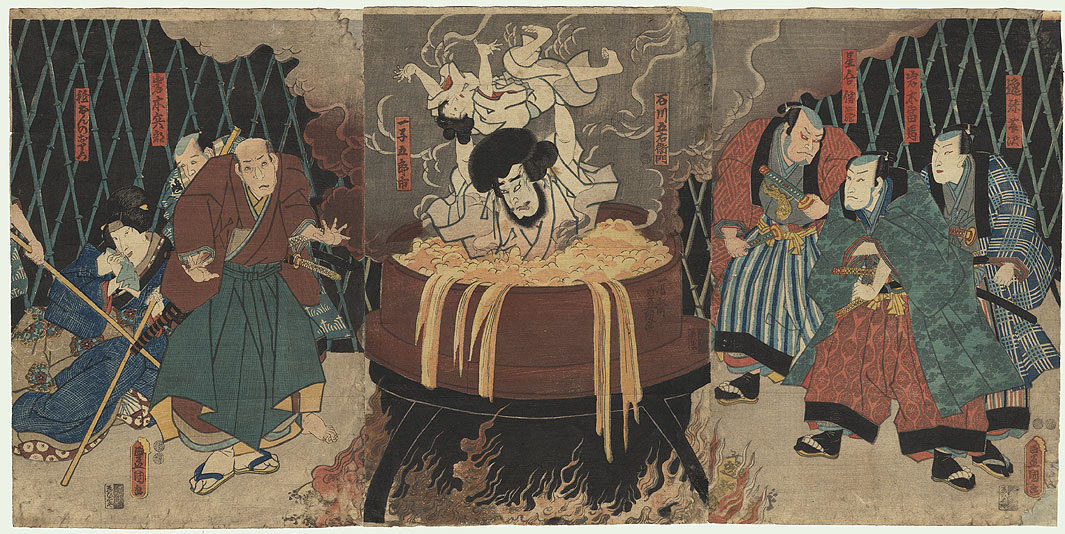
when Horror Yearbook – Oden captivated One Piece fans through his epic storyline that ended with a brutal execution by boiling. The scene was called the Legendary Hour and became one of the most emotional moments in the series. Oden was not just a powerful samurai but also a symbol of courage and self-sacrifice. He once carried nine of his comrades above his head while enduring scalding oil. This extreme act of heroism drew attention for more than just fiction. Fans noticed that Oden’s tragic fate resembled the story of Ishikawa Goemon, a real-life figure from Japanese history. Goemon’s tale also ended in a boiling execution, sparking speculation that Oda took inspiration from history when creating Oden. The blending of myth and fact continues to fascinate audiences, especially when the real story is just as gripping as the one crafted in a manga panel.
The tale of Oden takes on new meaning when compared to Ishikawa Goemon. Oden’s Legendary Hour closely resembles the final moments of Goemon, who faced boiling punishment with his child. Like Oden, Goemon became a symbol of defiance. His life story includes battles, rebellion and dramatic sacrifice. Born into a samurai family under the name Sanada Kuranoshin, Goemon turned into a ninja after his father’s murder. He sought revenge but his personal life brought complications. An affair with his teacher’s mistress forced him to flee. Changing his name to Ishikawa Goemon, he built a crew of outlaws. The resemblance between Oden and Goemon is not only in their execution but in the spirit of their rebellion. Both challenged authority in their time. Both paid the ultimate price, and both left behind tales of bravery that continue to inspire.
“Read about: You Won’t Believe These 4 Magical Monkeys That Shaped Chinese Mythology!”
Goemon lived in the Sengoku era and left behind a complicated legacy. He is best known as a thief who stole from the rich to help the poor. Much like Robin Hood, he gained public admiration. His operations took place mostly at night, targeting nobles and wealthy merchants. During the day, he disguised himself as a merchant to study the homes he planned to rob. Goemon used this double life to avoid capture and build loyalty among his followers. Despite his noble intent, Goemon was still hunted by authorities. Historical records are sparse, but his name appears in the biography of Toyotomi Hideyoshi. This famous warlord became his target. Goemon blamed Hideyoshi for the death of his wife. This personal vendetta pushed him to attempt an assassination that ultimately led to his downfall. His cunning, mission and tragic end elevate his tale to the level of folklore.
“Read more: Nowhere Left to Run: Khan Younis Declared Uninhabitable Amid Gaza Crisis!”
Goemon’s plan to kill Hideyoshi involved infiltrating Fushimi Castle. He believed that taking out the powerful warlord would avenge his wife and bring justice. Goemon devised a quiet entry, aiming to carry out the mission without raising alarms. However, fate had different plans. During the attempt, he accidentally knocked over a bell. The noise woke the guards. They caught him before he could complete the mission. The failed assassination sealed his fate. He was sentenced to die by boiling, along with his young son. The image of a father trying to protect his child in such a horrific moment echoes the fictional actions of Oden. Goemon’s final moments were recorded as acts of both desperation and heroism. The details may vary across versions, but the essence of his sacrifice remains intact. His story survives through generations, adding weight to the myth.
The most powerful part of Goemon’s tale lies in his execution. Placed into a boiling cauldron with his son, Goemon tried to shield the child from the searing heat. Some versions say he lifted the child above his head. Others say he chose to end his son’s suffering quickly. Either way, his final act is remembered as one of courage. Oden, in a similar display, held nine men above his head while being boiled alive. This exaggeration fits the style of One Piece but still draws a clear line back to Goemon. Both stories explore the idea of enduring pain for the sake of others. Whether fictional or real, these acts of self-sacrifice resonate deeply. They highlight what it means to stand firm in the face of cruelty. That is why Goemon and Oden continue to be remembered as heroes who chose principle over survival.